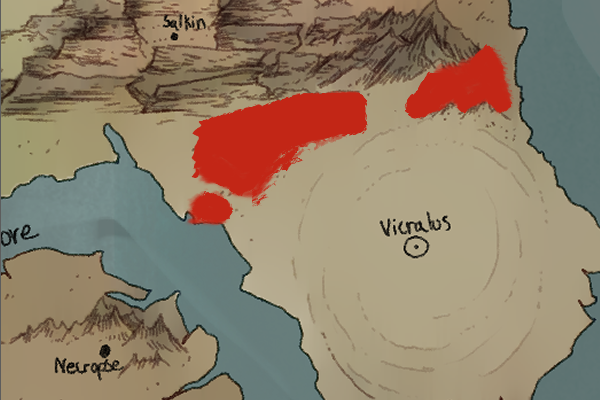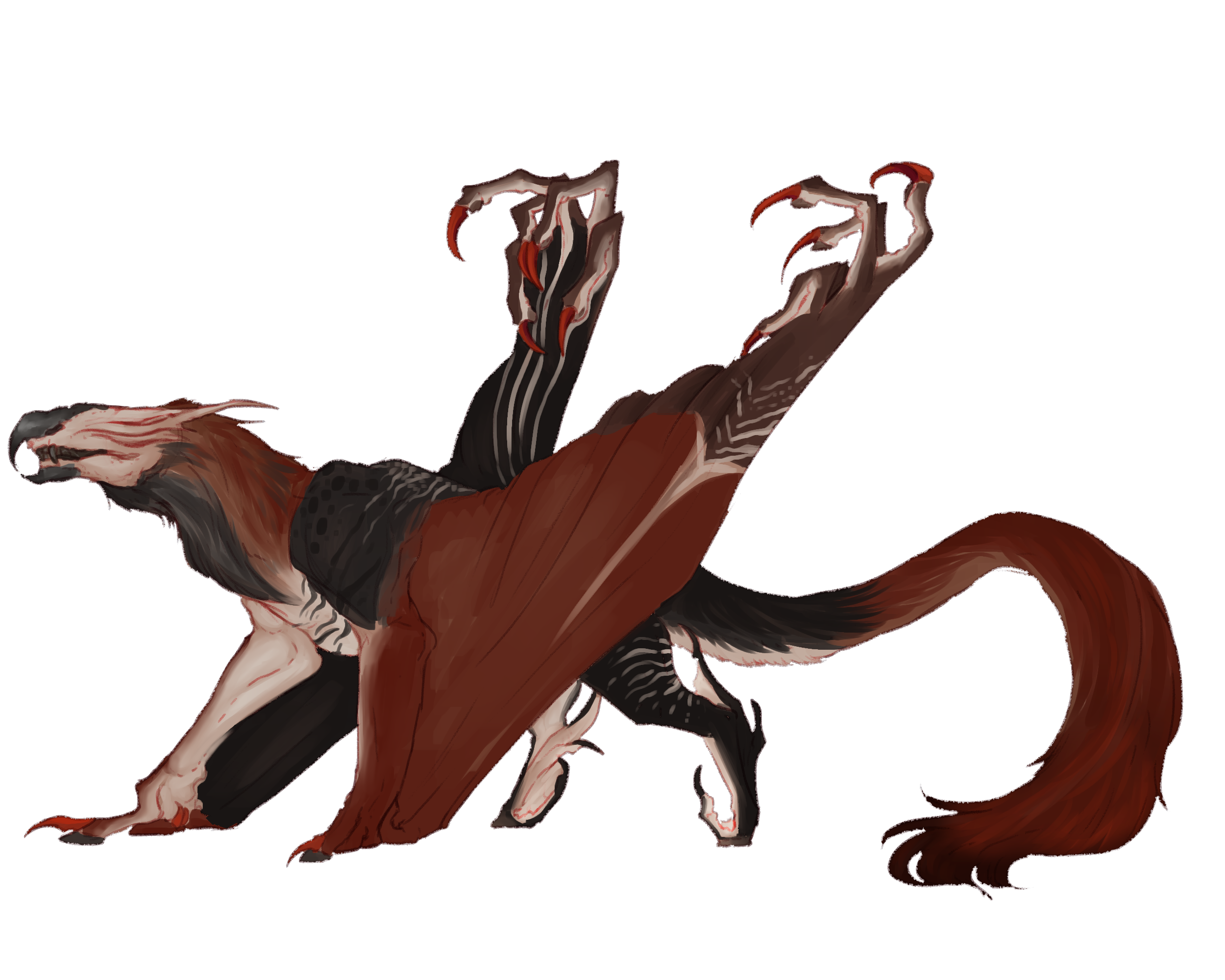
ID: F.CA.2.001
Name: Trackenshaw
Sub Order: Heavy is the wings that lift off the dust,
Hellish is the electric wild that sees
Class: Pretaria
Sub Class: Cscarthine
Order: Carnfor
Group: Shaw
Sub Group: Helllighters
Height: 36-42ft
Wingspan: 70-90ft
Weight: 12,000-13,000lbs
Length: 50-60ft
Related Species:
Calls:
Range
Trackenshaw roam the winds just outside The Singing Deathsands, managing their dusty territories with immense vigilance. On occasion they stray into the sands, but mainly they keep to their areas of hunting expertise.

Trackenshaw
Overview
With an impressive wingspan of eighty feet, the Trackenshaw is an extremely heavy aerial apex predator. These beasts spend their lives in the air, only landing quickly to eat before ascending to the clouds once again. Sertha’s dense atmosphere allows for the Trackenshaw to carry themselves on air drafts, and the desert's common storms allow for easy hunting. The Trackenshaw is an indiscriminate hunter, if it moves it will be targeted. No matter the size. Blind, these aerial predators fall into the subclass Cscarthine and thus are able to “see” using electromagnetic sensors in their heads. (See the slits in the face). Trackenshaw only hunt in electrical storms, of which Casaderea has more than enough due to this. Making them an extreme threat for travelers and fauna alike. The long wing fingers aid in its hunting habits, the Trackenshaw will identify a target and descend to them. Capturing and killing their prey by physically grappling with it, which strands the heavy Trackenshaw on the ground. A stranded Trackenshaw relies on wildfires from the storm or cliffs to ascend back into the air, as to to their incredibly long wings and heavy bodies. If they fail to ascend back into the air, they will not last on the ground and will be hunted down by other animals.
Temperment
Taming of Trackenshaw is extremely hard and rarely ever done, since the temperment of Trackenshaws is exceedingly poor. Reactionary animals with an extremely low intelligence prospect, and their size does not help them. Owners of Trackenshaw will find their belongings and living areas trashed if the Trackenshaw can fit, and they will oft find themselves the bitten hand that feeds. Violent and reactionary, Trackenshaw bite and claw at anything. They do not mate for life, and thus have no issue biting and snapping at the chosen mate for the time. Solidary, they are very territorial and do not care for mates in their space. If one chooses to overstay their due, a fight will dictate the new owner of the territory. Though Trackenshaw do attempt to not kill eachother, no matter how reactionary they are. Trackenshaw when rearing their own prefer a hands off observe from a distance type parenting. They typicaly don't react to any slights the young may do, only interacting when it is nessasary.
Life Cycle
A single parent will descend after a rain or flash flood, looking for a spot near a cliff they can take off of. Trackenshaw will birth live young, yet, as its young are pathetic for the first two weeks. The parent will encase them in mud, and burry them before leaving. For these two weeks, the Trackenshaw young are in a comatose state while their senses and muscles define, before together helping eachother burst out of the ground. The young Trackenshaw stick together, with their parents hands off stance to parenting. Often they will rely upon eachother for protection. These early years are spent on the ground, one of the most dangerous places for a Trackenshaw. As young, they are covered in hard grey scales. The scales are comprised of hardened fur and oils, as they age. The scales and fur in turn will change color and slowly start to unfurl into fur. As the young feast upon the roots of Ckinthe trees, whos roots are filled with fatty oil and the like. And as they move to a meat based diet, they will lose the scales. Often during their mid juvenile years will the group of young Trackenshaw finally split. Now on their own, much larger and heavier, they must figure out how to get into the air while they are still light enough to do it. Lest they end up stranded on the ground, waiting desperately for a electrical storm or to wander across to a cliff. These few months are the most dangerous, between the race to figure out they need to ascend, and the fact they will now face danger alone and blind. When they do get into the air, they will not land again unless it is to eat. Feeding off smaller slower aerial prey, they will increase their weight and spend more time sleeping. Then it is up to natural instinct to follow the pattern of storms seeking prey. The first hunt will always be a messy one, and the most dangerous. But after that is done, and until the animal finds its match. They are fated for a long existence in the hot desert of Casaderea.


